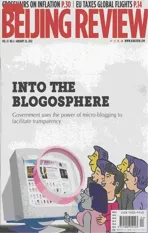Guiding Investment
2012-10-14UpdatedpolicywillyieldwinwinresultsforforeigninvestorsandChinaByLanXinzhen
Updated policy will yield win-win results for foreign investors and China By Lan Xinzhen
Guiding Investment
Updated policy will yield win-win results for foreign investors and China By Lan Xinzhen

NEW AND IMPROVED: Volkswagen reveals its new hybrid car at the 2012 North American International Auto Show on January 9. Key components of new energy vehicles are one of China’s newly added encouraged items for foreign investment
As part of ongoing efforts to attract foreign capital into China, the Central Government has adopted more open policies toward potential overseas investors.
Compared with its predecessor, the 2011 Catalogue Guiding Foreign Investment in Industry, effective January 30, increases the number of items in the category of encouraged investment, reduces the number of items in the categories of restricted and prohibited investment and eliminates the limit of shares by foreign investors in some sectors. For the items of encouraged investment, foreign investors will enjoy related favorable policies.For example, in central and western regions,foreign investors can receive a 15-percent corporate income tax break.
“To adapt to the new situation of deepening economic globalization, China will adopt a more active and open strategy, expand more sectors of opening, promote reform and development via opening and create a better investment environment,” said a news release from the National Development and Reform Commission (NDRC).
The catalogue is an important industrial policy that China uses to guide foreign direct investment. Since its introduction in 1995, it has been revised fi ve times to meet the needs of economic development and opening up.
Ten years have passed since China’s accession to the WTO. Now that China is closely connected with the world economy and its investment environment has improved continuously. As a result, the scale of foreign investment has expanded, ranking second in the world. Foreign investment has played an active role in promoting China’s economic growth, creating jobs, upgrading industrial structures and expanding foreign trade.
However, China still faces various challenges in utilizing foreign investment.According to a release from the NDRC, in China, prices of capital goods rise rapidly and upgrading of industrial structure is urgent.In the international community, the global fi nancial crisis has created the need to make major changes to the global economic structure. These changes require China to further optimize the structure of foreign investment and improve the ef fi ciency of utilizing foreign capital. This is one of the reasons that China is creating a more welcoming environment for foreign investment.
Another reason is that since foreign investment is an important part of China’s opening-up process, the Chinese Government hopes to appropriately readjust its industrial policies for foreign investment by revising the catalogue, actively guiding foreign investment and promoting ongoing economic restructuring, and transforming the country’s economic growth pattern.
Serving the restructuring
In 2012, with the U.S. dollar still relatively weak and the European debt crisis far from over, international capital will favor the Chinese market. Facing the growing scale of foreign investment, China must utilize this favorable factor and continue to constantly improve the ef fi ciency of introducing foreign investment.
The catalogue intends to guide foreign investment into high-end manufacturing industries, strategic emerging industries and the recycling economy, which are the key sectors during the restructuring of petroleum and chemical industries, and also pillar sectors of future development of industries.
To promote upgrades to the industrial structure, the NDRC will guide more foreign investment into industries such as modern agriculture, new technologies, advanced manufacturing, new energy and modern services to develop a modern industrial system. By expanding the service sector and enhancing coordination of primary, secondary and tertiary industries, the commission will encourage transnationals to increase input in research and development (R&D) in China,establish R&D centers and cooperate with Chinese companies in R&D to improve ties with foreign investors and enhance China’s independent innovation capabilities.
The catalogue also restricts or prohibits foreign-funded projects featuring “high pollution and high energy and resource consumption.” In order to curb access capacity and redundant construction, the catalogue removes industries like polycrystalline silicon and coal chemical from the category of encouraged investment.
Wang Haisheng, an analyst at Huatai United Securities Co. Ltd., said throughout the world, polycrystalline silicon projects have been excessive. At present, the production capacity of the world’s top five photovoltaic enterprises related to polycrystalline silicon can fully satisfy the market demand.Moreover, the development of Chinese polycrystalline silicon industry has already reached the world level, sti fl ing the need for foreign investment.
Newly Added Encouraged Investment Items
● High-end manufacturing industries:new products and new technologies in textile, chemical and mechanic manufacturing industries; and recycling and disposal of waste electric and electronic products, machinery equipment and cells.
● Strategic emerging industries: key components of new energy automobiles and next-generation Internet system equipment based on IPv6.
● Modern service industries: electric vehicle charging stations, venture capitals, intellectual property right services,cleaning technologies of marine oil pollution and professional skill training.
● Non-regular oil and gas: foreign-invested exploration and development of non-regular oil and gas resources such as oil shale, oil sand, heavy oil, extraheavy oil, shale gas and seabed natural gas hydrate (only joint venture and Chinese-foreign cooperative ventures).
Financial leasing allowed
The catalogue has removed foreign-invested fi nancial leasing companies from the category of limited investment to that of allowed investment.
Financial leasing is called cardiac stimulant during economic recession. In the background of global economic recession and tightened money supply in various countries,bank credit has been unable to satisfy the demand of engineering enterprises, therefore fi nancial leasing has become a big source of funds.
Yang Haitian, Editor in Chief of theBlue Book of China’s Leasing Industry, said in many countries, fi nancial leasing is the second largest fi nancing source after bank credit. In China, fi nancial leasing is still in its infancy.
After China entered the WTO, foreigninvested leasing started development in China, but its growth has been restricted with high requirements on access and business operations. In 2005 China issued Management Measures of Foreign-Invested Financial Leasing Companies. Some Chinese banks and companies also began to enter the financial leasing industry. In 2007, China promulgated Management Measures of Financial Leasing Companies, which covered domestically invested companies.
According to theBlue Book of China’s Leasing Industry, by now there are more than 280 financial leasing companies in China,including 20 bank-invested ones, 60 manufacturer-invested ones and 200 independent ones.Among them, 66 are domestically invested and more than 200 are foreign invested.However, bank-invested financial leasing companies, all domestically invested, occupy more than 60 percent of the domestic market share, and foreign-invested financial leasing companies have not fully released their strength in China.
Yang said removing financial leasing from the category of limited investment to that of allowed investment will help promote the development of China’s financial leasing industry, expand financing channels and alleviate the industry’s bottleneck of capital shortages.
